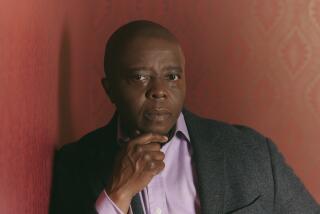Critic’s Notebook : Some ‘Burning’ Questions
With “Mississippi Burning,” director Alan Parker raises more than a few solid questions for reviewers: How much tampering with the facts can be accepted in the name of a good cause? Granted that Parker has insisted that his film is fiction. However, it’s fiction set solidly in the facts of the day: The disappearance of three civil rights workers in the first days of the Mississippi Summer Project in 1964. His young men match the murdered Michael Schwermer, Andrew Goodman and James Chaney down to their race, their accents and even one man’s “beatnik” goatee.
The film leaves nobody neutral. I know that in my own case, it provoked a heated luncheon discussion with a visiting film maker-friend who found the picture stunning. He listened patiently to my catalogue of demurs, then said he thought I’d be wrong to bring them up in a review; that--unlike many of us who’d lived through that period, no matter how safely removed from Neshoba County, or Selma or Birmingham--there was a whole generation who would be learning about the civil rights movement from this film. For them, he felt, the film’s portrait of the real conditions in rural Mississippi 24 years ago so far outweighed its omissions or its bending of facts, that it becomes almost one’s duty to support it.
I certainly understand his concern. There are few enough American movies to deal with social issues at all today, so that the ones that do seem to carry a special weight. That’s especially true with a film that’s made as persuasively as “Mississippi Burning,” which is what makes its deficiencies so especially troubling.
I think my friend’s premise brings up more difficulties than it solves: If this film is all you know about Mississippi in the 1960s, you’re going to have a pretty peculiar picture of those apocalyptic times and especially of the ways change was finally brought to the South.
Many of the other writers who were disappointed by the film were struck by the same point that I was trying to make during that arm-waving lunch: “Mississippi Burning” is missing a lot more than three civil rights workers. Parker seems to have left out black activism altogether. His black citizens are cast almost uniformly as victims, there to be beaten, reviled or lynched; the leader among them is a boy preacher who appears to be about 11. To judge from this film, neither the Student Non-Violent Coordinating Committee nor the Congress of Racial Equality existed. Where were the Freedom Riders or the rest of the Mississippi Summer Project volunteers? You’d have to ask Parker or his writer, Chris Gerolmo.
What Parker doesn’t seem to have gotten straight is the authorship of the movement whose existence is the core of his story. The civil rights movement in Mississippi was the spontaneous creation of young black students. Its gains came about because of the patient, bloody stoicism of these men and women who endured unconscionable abuse, who were jailed, beaten and murdered until, in desperation, they invited white students to join them, well aware of the risk involved. It was only when two white New Yorkers were murdered with a black Mississippian, that America finally acted.
The FBI had certainly not turned out in force a year before, when four little black girls were murdered in Birmingham, Ala., as the Ku Klux Klan dynamited their church. Under Hoover, the bureau had been notoriously diffident in acting on complaints of civil rights violations in the past. The sympathies of many of the agents who were also Southerners were hardly a secret. But the death of two white men alongside one black one made this case different. Prodded by President Lyndon Johnson, Hoover sent 100 agents to Mississippi by the end of June, and in July opened a branch office in Jackson, Miss. The film, however, takes the presence of these hundred men in their dark shirts, white shirts and narrow ties only as heroic, not historically ironic.
Certainly, it was those 44 days when FBI agents swarmed into this little town, their arrest--and the subsequent prosecution--of some of the guilty men that finally “turned the state around,” in the words of Seth Kagin. (Kagin is co-author with Philip Dray of “We Are Not Afraid,” the detailed account of the Goodman/Schwermer/Chaney murders and an invaluable portrait of the climate of those times.)
The FBI presence helped break down the unspoken but very real link between much of Mississippi’s law enforcement and the Klan, the situation that had foiled attempts to register voters, or even to have an accredited black student admitted to Ole Miss. But it’s a peculiar perversion of the facts to eliminate the very people whose ingenuity and bravery had carried the movement this far.
“Mississippi Burning” is most haunting as it sketches an entirely fictional exchange between Frances McDormand as the wife of the town’s deputy/suspect and Gene Hackman’s canny, drawling Southern FBI man Anderson. It’s the one part of the film where there is room not only for ambiguity but for change and growth within characters. Mrs. Pell, who has married her weak, bullying husband (played by Parker regular Brad Dourif) right out of high school, has been watching events around her with growing disquiet. Anderson watches her, sure that she is the key to their investigation. And, the film hints, out of his own loneliness and isolation, he may begin to feel something for this unhappy woman, almost as isolated as he.
Part of the film’s pull comes from the delicacy of the playing between Hackman and McDormand. Hackman’s mastery at suggesting an infinite number of layers beneath a wry, self-deprecating surface reaches a peak here, but McDormand soars right with him. And since she is the film’s sole voice of morality, it’s right that she is so memorable.
However, when the film makers turn their attention to the FBI itself, all delicacy vanishes. In “Mississippi Burning’s” view of things, the case is broken only when Anderson insists that his methods are the only ones that will work. His tactics begin with a grip on an opponent’s genitals and end with kidnaping and a threat of castration. The FBI played rough, but in their usual manner, by infiltration and paying informants. There is nothing in the reams of evidence that authors Kagin and Dray sifted through that suggested intimidation on the movie’s melodramatic scale.
Well, bribery isn’t very cinematic. Easier to have a hemi-semi-demi love affair, and the threat of castration to turn the tide (even that is specious since it’s made by a “black FBI” agent to a white mayor and there were no black agents in the FBI.) What makes this approach so especially disheartening is that this wasn’t the way truth finally prevailed there in Neshoba County. A $30,000 bribe turned the tide, not brute force.
“Mississippi Burning” not only walks away from its own bogus moral issue, descending to your opponent’s gutter in order to beat him, it feeds the Klan’s fondest image--of the FBI as tyrannical and lawless. Like “Betrayed,” parts of “Mississippi Burning” are a racist’s dream. (The fact that both directors Parker and Costa-Gavras are not native to America may not be incidental, either.) If white supremacists can believe that they lost only because the FBI was dirtier and more vicious than they cared to be, then their mythology as victims and martyrs remains unchallenged.
Not incidentally, by portraying the Klan as seemingly random and scattered outsiders instead of a force whose connections ran through virtually every white official in the state, the film downplays the Klan’s entrenchment and its lethal power in Mississippi.
All these elements, in a movie which wears its good intentions so bravely on its sleeve, make “Mississippi Burning” a not-uncomplex matter for its audiences, certainly a thorny one for any reviewer, as well as the cornerstone of more than one good, brisk lunchtime debate.
More to Read
Only good movies
Get the Indie Focus newsletter, Mark Olsen's weekly guide to the world of cinema.
You may occasionally receive promotional content from the Los Angeles Times.










